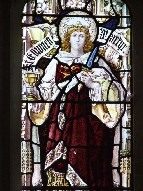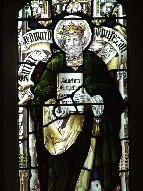| |
|
St Mary,
Brettenham
 |
|
It
was the day of the 2008 Historic Churches Bike
Ride. On this day, churches all over England stay
open, and people are sponsored to cycle between
them. You can also walk, and the welcomers at
each church can also collect sponsors. The event
is particularly well supported in East Anglia,
where it first began nearly thirty years ago. It
raises thousands of pounds every year, half of
which goes to the Historic Churches Trust of the
county in question. The other half goes directly
to the home church of the sponsored cyclist, so
some smaller churches take the day very
seriously. My perception, generally, is that
fewer and fewer people are taking part each year,
but the amount of money raised seems to keep
going up. We'd just been to Riddlesworth.
There, the church had been locked and bolted,
just as it always is. There was nobody on duty
there, no one to welcome cyclists or walkers.
Given that the church is a good half a mile from
the nearest road, I thought that this was a bit
rich. At the very least, they could have put a
sign out up on the main road. Something along the
lines of Riddlesworth Church is not taking
part in the Historic Churches Bike Ride. We have
no interest in raising funds for historic
churches, and furthermore we will never ask for a
grant from the Norfolk Historic Churches Trust
would have done. Unfortunately, a similar sign at
Brettenham would also have been needed, because
Brettenham church was also locked up without any
sign of life.
|
To be
honest, I had expected this. The nice lady at Rushford
had already told us that Brettenham church had been
effectively abandoned. There was no one in the parish
interested in keeping it open, and services were no
longer held there. You could tell that from the air of
neglect. Although the graveyard was neatly clipped,
presumably for the activities of the pagan cult of the
dead, the church itself was shabby and dirty, with holes
in the windows and the porch full of dead leaves.
This is a
great shame, because Brettenham church is one of the
major East Anglian works of the 19th century architect SS
Teulon. He had been appointed by Lord Buxton to rebuild
Shadwell Park, the great house to the east of the church,
and in 1852 he turned his attention to replacing the
little Norman building which had previously stood on this
site. He retained the base of the 14th century tower and
the Norman south doorway, but everything else here is
his. It must have cost a fabulous amount of money. The
church underwent another massive restoration in the first
decade of the 20th century, when all the stained glass
and furnishings installed by Teulon were removed (the
woodwork went to Rushford) and replaced in an elegant Art
Nouveau style. The glass is one of the most extensive
ranges in East Anglia of the work of AL Moore. The glass
means that it is impossible to see inside, but by poking
a camera through some of the numerous holes it was
possible to photograph part of the screen, and some of AL
Moore's beautiful work.
| A
sign told us that, if we wanted to see inside, we
would need to call at one of the local farms and
speak to the owner. The farmyard turned out to be
a lorry depot, and we asked a man with his head
under a bonnet if the owner was about. He
helpfully went to a shed to phone up, coming back
to tell us that the boss would be down in a
minute; but these must have been south Norfolk
minutes, because we waited for nearly half an
hour, and nobody turned up. It was a shame, but
there were other churches to see, and so we left,
driving back past St Andrew on the way to the
Suffolk border in search of friendlier and more
welcoming churches. I thought
about it later, and it made me a bit cross.
Thousands and thousands of pounds were spent on
this building, millions in todays money, in two
significant restorations, and it has now just
been left to rot. It hasn't been declared
redundant, and even if it was it is not certain
that the Churches Conservation Trust would be
asked to take it on. It really needs some kind of
emergency compulsory purchase, perhaps by English
Heritage, before things are allowed to go too
far; but there is no mechanism for this. At the
very least, St Andrew needs to be placed on
Norfolk County Council's Buildings at Risk register
as soon as possible.
|
|
 |
|
|
|
